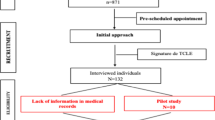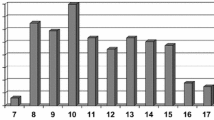Abstract
This nationwide study aimed to evaluate health-related quality of life (QoL) experienced by children after tetralogy of Fallot repair and to compare self-reported physical ability with objective exercise performance. This prospective nonrandomized, government-funded multicenter study enrolled 168 patients (70 girls; ages 8–16 years) after tetralogy of Fallot repair at eight German heart centers. Health-related QoL was analyzed by the self-reported KINDL-R quality-of-life questionnaire. The patients’ actual exercise capacity was evaluated by a cardiopulmonary exercise test. Health-related QoL and cardiopulmonary exercise capacity were compared with those of an age-matched German standard population. Correlation of health-related QoL with self-estimated physical rating and cardiopulmonary exercise capacity were analyzed. Health-related QoL in children and adolescents after tetralogy of Fallot repair is without limitation. Compared with the standard population, all the items evaluated by the KINDL-R questionnaire showed better or similar values, whereas objective exercise capacity compared with that of the standard population was impaired. Peak oxygen uptake correlated significantly with the physical well-being (p = 0.002) and the total score (p = 0.01) of the KINDL-R questionnaire. Health-related QoL experienced by children and adolescents after tetralogy of Fallot repair is comparable with that of the healthy standard population. However, closer inspection shows that self-estimated physical functioning is significantly overestimated compared with actual exercise capacity. Quality-of-life instruments and exercise tests, therefore, should be used in a complementary manner with children to avoid eventually fatal misinterpretation of patient-estimated physical ability.




Similar content being viewed by others
References
Apitz C, Webb GD, Redington AN (2009) Tetralogy of Fallot. Lancet 374:1462–1471
Badiah Llach X, Benavides Ruiz A, Rajmil L (2001) Instruments for measuring health-related quality of life in children and adolescents with asthma. An Esp Pediatr 54:213–221
Bertranou EG, Blackstone EH, Hazelrig JB et al (1978) Life expectancy without surgery in tetralogy of Fallot. Am J Cardiol 42:458–466
Dubowy KO, Baden W, Bernitzki S et al (2008) A practical and transferable new protocol for the treadmill testing of children and adults. Cardiol Young 18:615–623
Gratz A, Hess J, Hager A (2009) Self-estimated physical functioning poorly predicts actual exercise capacity in adolescents and adults with congenital heart disease. Eur Heart J 30:497–504
Hager A, Hess J (2005) Comparison of health-related quality of life with cardiopulmonary exercise testing in adolescents and adults with congenital heart disease. Heart 91:517–520
Hager A, Hess J (2005) Comparison of health-related quality of life with cardiopulmonary exercise testing in adolescents and adults with congenital heart disease. Heart 91:517–520
Hövels-Gürich HH, Konrad K, Skorzenski D et al (2007) Long-term behavior and quality of life after corrective cardiac surgery in infants for tetralogy of Fallot or ventricular septal defect. Pediatr Cardiol 28:346–354
Lillehei CW, Cohen M, Warden HE et al (1955) Direct vision intracardiac surgical correction of tetralogy of Fallot, pentalogy of Fallot, and pulmonary atresia defects: report of first ten cases. Ann Surg 142:418–442
Loup O, Weissenfluh C, Gahl B et al (2009) Quality of life of grown-up congenital heart disease patients after congenital cardiac surgery. Eur J Cardiothorac Surg 36:105–111
Maune S, Kurz K, Meyer J et al (2005) Quality-of-life assessment in otorhinolaryngology: history, measures, and methods. Otolaryngol Pol 59:489–504
Mir TS, Brockhoff C, Eiselt M et al (2000) Messung der gesundheitsbezogenen lebensqualität (lq) von erwachsenen mit angeborenen herzerkrankungen mit dem SF-36 health survey. J Kardiol 7:506–511
Murphy JG, Gersh BJ, Muir DD et al (1993) Long-term outcome in patients undergoing surgical repair of tetralogy of Fallot. N Eng J Med 329:593–599
Nollert G, Fischlein T, Bouterwek S et al (1997) Long-term survival in patients with repair of tetralogy of Fallot: follow-up of 490 survivors of the first years after surgical repair. J Am Coll Cardiol 30:1374–1383
Pigula FA, Khalil PN, Mayer JE et al (1999) Repair of tetralogy of Fallot in neonates and young infants. Circulation 100(19 Suppl):157–161
Pilla CB, Pereira CA, Fin AV et al (2008) Health-related quality of life and right ventricular function in the midterm follow-up assessment after tetralogy of Fallot repair. Pediatr Cardiol 29:409–415
Ravens-Sieberer U, Bullinger M (1998) Assessing health-related quality of life in chronically ill children with the German KINDL-R: first psychometric and content analytical results. Qual Life Res 7:399–407
Ravens-Sieberer U, Erhart M, Wille N et al (2008) Health-related quality of life in children and adolescents in Germany: results of the BELLA study. Eur Child Adolesc Psychiatry 17:148–156
Rawlins MD, Culyer AJ (2004) National Institute of Clinical Excellence and its value judgments. BMJ 529:224–227
Utens EM, Versluis-Den Bieman HJ, Verhulst FC (1998) Psychopathology in young adults with congenital heart disease. Eur Heart J 19:647–651
Wee HL, Lee WW, Ravens-Sieberer U et al (2005) Validation of the English version of the KINDL-R generic children’s health-relate quality of life instrument for an Asian population: results from a pilot test. Qual Life Res 14:1193–1200
Wee HL, Ravens-Sieberer U, Erhart M et al (2007) Factor structure of the Singapore English version of the KINDL-R children quality of life questionnaire. Health Qual Life Outcomes 19:4–5
Kompetenznetz für angeborene Herzfehler. www.kompetenznetz-ahf.de
Acknowledgments
The authors strongly acknowledge all the participating centers for their efforts during the trial. This study was part of the Competence Network for Congenital Heart Defects funded by the German Federal Ministry of Education and Research (BMBF), FKZ 01G10210.
Conflict of interest
None declared.
Author information
Authors and Affiliations
Corresponding author
Rights and permissions
About this article
Cite this article
Mueller, G.C., Sarikouch, S., Beerbaum, P. et al. Health-Related Quality of Life Compared With Cardiopulmonary Exercise Testing at the Midterm Follow-up Visit After Tetralogy of Fallot Repair: A Study of the German Competence Network for Congenital Heart Defects. Pediatr Cardiol 34, 1081–1087 (2013). https://doi.org/10.1007/s00246-012-0603-2
Received:
Accepted:
Published:
Issue Date:
DOI: https://doi.org/10.1007/s00246-012-0603-2




